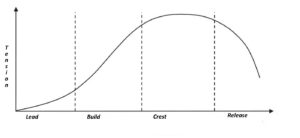As a guardrail, fear isn’t such a bad emotion. Fear keeps us from sticking our hands into the fire a second time. But what about fear as manipulation? Fear of the unknown, fear of missing out, fear of repeating history…this kind of fear is subtler. How good are you with this kind of fear? Would you like to know how to own your own dopamine?
Success and The Algorithm
Let’s start by taking a look at what feeds our fears and beliefs and how that’s related to our built-in feel-good reward system: dopamine.
A prevalent belief about the Internet is that success comes to the popular. Let’s use that to explore fear.
Driving to the top of any particular set of search results isn’t hard if you or your thing are truly unique. But truly unique stuff isn’t stuff anyone searches for, since The Algorithm – how content gets presented on the ‘Net – works best for stuff that’s not novel. The Algorithm goes to work once stuff becomes known more than other stuff, and exponentializes rewards for the stuff that’s most popular.
The pre-Internet Pet Rock is a good organic example of how this worked back in the day. TikTok’s skateboarding Gatorade Guy is Exhibit A as I write this.
Today, we believe that if we define our thing specifically, differentiate our thing from all the similar things, and take a run at the popularity contest (which usually involves being the noisiest content creator in the lane), then presto: we can have success!

But not always. Someone or something else can always be louder – or scarier, or shinier – than you or your thing. Like fool’s gold, you or your thing could flash in the pan for a moment before the ‘Net moves on to what’s next…because that’s how most human attention flows. We drive The Algorithm toward what’s shiny.
Think about it.
Fear and The Algorithm
Here’s a broader example of how it all works. Headlines that are sensationally, patently false – “OctoMom Gives Birth to Space-Alien!” – grab our attention, so we click…and make our tiny mark in the “yes: popular” column. The Algorithm doesn’t care whether or not we agree or disagree with the headline: our click is a vote.
For those who actually watch, listen, or read below the headline, The Algorithm keeps track of our presence. The amount of time we spend with the content becomes a second quantitative measure of its popularity. More clicks and more time spent (more popularity) is, sadly, misunderestimated – not by The Algorithm but by us! – as some kind of value metric for the content. Ergo: content that is utterly worthless can become vastly popular, and feed the promote promote, promote, cycle ad nauseam until something more popular comes along.
The Algorithm rewards popular content regardless of whether it contains obvious scare tactics or real value.
The Algorithm is designed to reward popular content regardless of whether it contains any kind of obvious scare tactics or real value. It just doesn’t care to make the distinction. And, sadly for human consumers, we’re susceptible to dopamine-boosting content whether or not it’s intended to manipulate us.
Fear and Belief
The Algorithm is especially good at attracting us when it offers content that is aligned with our belief systems. When it comes to dopamine we are like flies around honey, and content that rewards us by aligning with our beliefs is a great way to feel, well, really great about what we believe.
But what if our beliefs are either based on fear or fatally unsustainable?
Great question. When it comes to learning not to put one’s hand into a fire, we generally believe that open flames must be controlled. When the flames are out of control we use our beliefs and fears to get the hell out of the forest, for example, before the forest fire burns us, too. That’s self-evident (I hope), but even if you’ve never been up close and personal with a large open fire, it could also be your very credible belief.
Beliefs that aren’t self-evident, especially ones that are in any way esoteric or impossible to prove empirically are much more susceptible to manipulation, especially by fear. Radical fundamentalists, for example, threaten unbelievers with death, in spite of what could be equally fundamental but different beliefs of those they deem unbelievers. That is fear-based manipulation.
Suckers for dopamine
The Algorithm, while it doesn’t actually “know” this, is still designed to promote what triggers the most dopamine. Confirming our beliefs is a huge dopamine trigger, just like puppies and kittens. Therefore, even fear-based manipulation, provided it aligns with what anyone believes (Yay dopamine!), rises to the top of what we are offered online.
Belief confirmation is a huge dopamine trigger
Like those supermarket tabloids, the craziest headlines fit right into The Algorithm’s sweet spot, and like a snowball rolling downhill…well, you get the picture. Conspiracy theories, weird and goofy New Age ideas, and pseudo-science are treated by The Algorithm as if they are just as valid as scientific evidence or undisputed facts (are you listening, Flat-Earthers?) simply because this kind of poppycock can rise to the top of the noisy popularity contest…and who wants to be in the position of judging validity of the content, right? That might smack of censorship and we wouldn’t want that!
Still, it’s logical to ask: given the choice, who wouldn’t choose dopamine?
The Emperor is still naked
Hans Christian Anderson was probably not the first to write an allegorical story about mass manipulation. The Algorithm would have loved that story; think of all the clicks the Emperor’s loyal subjects would have given to images of him displaying his latest peacockery.
Unfortunately, the Emperor and all of his subjects were swindled by a couple of thieves posing as weavers of a fabric they claimed was invisible to anyone stupid or incompetent. Who would voluntarily cut off their own dopamine by admitting to not see this marvelous fabric? Think of all the dopamine-induced support for this belief!
It was all undone by a clear-sighted, innocent child, who simply observed and reported on the actual facts anyone else could see – but that no one would admit out of fear of being thought stupid or incompetent.

Was there fear in this story? Manipulation? Certainly!
The point is that The Algorithm plays to accepting the folktale Emperor’s nakedness as some spectacular new suit of clothes instead of the obvious chicanery that it is. We, with our susceptibility to dopamine, go along with it, eventually falling into the trap fear laid for us: it’s too much of a personal risk to be honest about the obvious facts.
Fear versus facts
Factually, the Emperor’s outfit was was nothing to fear, but that didn’t stop fear of an unfounded belief from propagating kingdom-wide. The trouble with such beliefs, of course, is that they can be undone very simply by one who’s unafraid of the truth. Think of the potential dopamine hit for everyone in that story! Surprise followed by relief.
This is not to challenge any of your beliefs. They are precious to you, and only you can decide what you believe. Instead, the purpose here is to measure your beliefs against actual fear. And we’re going to do that boldly, in spite of Daniel Patrick Monyhan’s often-quoted solipsism: “Everyone is entitled to his own opinion, but not entitled his own facts” (pronouns are his).
Unless all of us measure our beliefs – challenge them regularly to provide real-life proof of their validity – we can become susceptible to The Algorithm. How? By letting manipulative fear guide us to the dopamine we crave.
Fear, let’s face it, isn’t irrational when we’re terrified. A scary movie, the Unknown, fear of missing out – these are not irrational when we experience them in the moment. If the fear lingers after the scary movie we rationalize that what we felt was triggered by a portrayal of some terrifying event rather than our direct experience of the event. It can be difficult to separate the actual event from the portrayal, since our subconscious doesn’t distinguish between the two.
That’s an important point:
Our subconscious doesn’t distinguish between an actual fear-triggering event and the portrayal of that same event. We have post-traumatic stress because trauma (past fear) lingers.

Try recalling a scary thing that happened to you; you can still feel the fear, correct? By the way, this is true for the other emotions as well: sadness, anger, and joy are just as “real” to the subconsciousness as they are in real life.
How to manipulate anyone emotionally
Because of the subconscious residue of remembered emotions, it’s possible to suggest future situations where those emotions might re-occur. The subconsciousness doesn’t know the difference between past, present, and future, so manipulators don’t need facts to tweak us into fear of the unknown, fear of missing out, or fear of repeating history. All that’s necessary is a suggestion, which is picked up by the conscious awareness and subsequently triggers the subconsciousness and wham! Fear.
While it’s possible to reason one’s way out of fear, or to offer factual evidence for the impossibility of a fear trigger (that is, falling off the edge of a flat Earth), when we’re triggered our subconsciousness doesn’t want the facts. All it wants is to feel better: the dopamine hit. Mental effort goes out the window and we become easy clickbait for whatever The Algorithm “knows” about how we can trigger some dopamine.
And how does that happen? Maybe its kittens and puppies, but these days the most popular kinds of dopamine hits are based on reinforcing our beliefs, so that’s what The Algorithm serves us. I can get rich, quickly or slowly; sex is natural, sex is fun; I’m able to support what I believe with Internet research; the Earth is flat. The antidote to fear could be anything that – what? All together now: triggers our dopamine. Dopamine confirms even the most irrational of our beliefs, so we feel better and justified. Correct?
The Algorithm lives on our human craving for dopamine. Not future dopamine; dopamine right now. That won’t change until our human cravings change.
The bottom line on fear
Admittedly, your particular beliefs may have stopped you from reading more than the headline on this article. But if you have read this far, you’ve learned how and why beliefs aren’t really an issue for The Algorithm: it doesn’t care so long as it can use what you believe to trigger your dopamine. So the bottom line on fear really comes down to a question: how susceptible are you?
Used well, fear is so much more incredibly powerful than a guardrail. Fear – and anger – have been both the cause of and the end of powerful world wars. Fear has helped establish nations. And fear keeps us from putting our hands into the fire a second time. But used to manipulate us? With great power comes great responsibility, right?

We – all of us worldwide – have bought into a worldwide dopamine-dominant web without insuring the intelligent management of its manipulative capabilities. We have factual evidence – all together now: Facebook, Google, Twitter, and TikTok – of how the free speech ethos of the Internet has been co-opted by greed and fear. (Yes, I realize that introducing beliefs about money at this point is risky, but it helps quantify the damage). And, if we continue to be driven by dopamine, there’s no evidence that things will improve for any of us who don’t make gobs of money from dopamine addicts subject to fear and willing to pay anything for the experience.
Doesn’t look good, does it?
The Antidote to The Algorithm
Disconnecting from the Internet isn’t reasonable, but for some, a disconnection from social media can be healthy. It offers a way to rediscover more natural dopamine triggers – to be less addicted to the noise of irrational popularity. Unfortunately, breaking this addiction and rising to an actionable level of awareness about the real issues just doesn’t happen without effort.
If you are learning about this for the first time, there is a way forward: question your fear. Ask yourself if you have a dopamine habit based in fear. If you do, change up your habit. Now. You don’t need to be driven by your subconsciousness when you have the ability to offer your subconsciousness peace instead of fear. This is what people in trauma therapy do.
“The Body Keeps the Score,” a seminal book in easy-to-digest language by Bessel Van Der Kolk, M.D., discusses both the ramifications of holding on to traumatic experience over time and the beautiful possibilities of transforming that traumatic experience, as well as habits that can be learned and used to make us less susceptible to fear-based dopamine triggers, such as those served up by The Algorithm.
If you’re afraid that you might be feeding The Algorithm, you’re not alone. Don’t put your hand in the fire again; use fear as a guard rail. That’s a good way to use fear since it offers you a choice about your next dopamine trigger. Will you make the noisy popular choice? Or will you own your own dopamine?
Bill Protzmann is an award-winning musician and educator and creator of The Musimorphic Quest, a music laboratory where passengers learn and strengthen dopamine-boosting, fear-busting skills.



